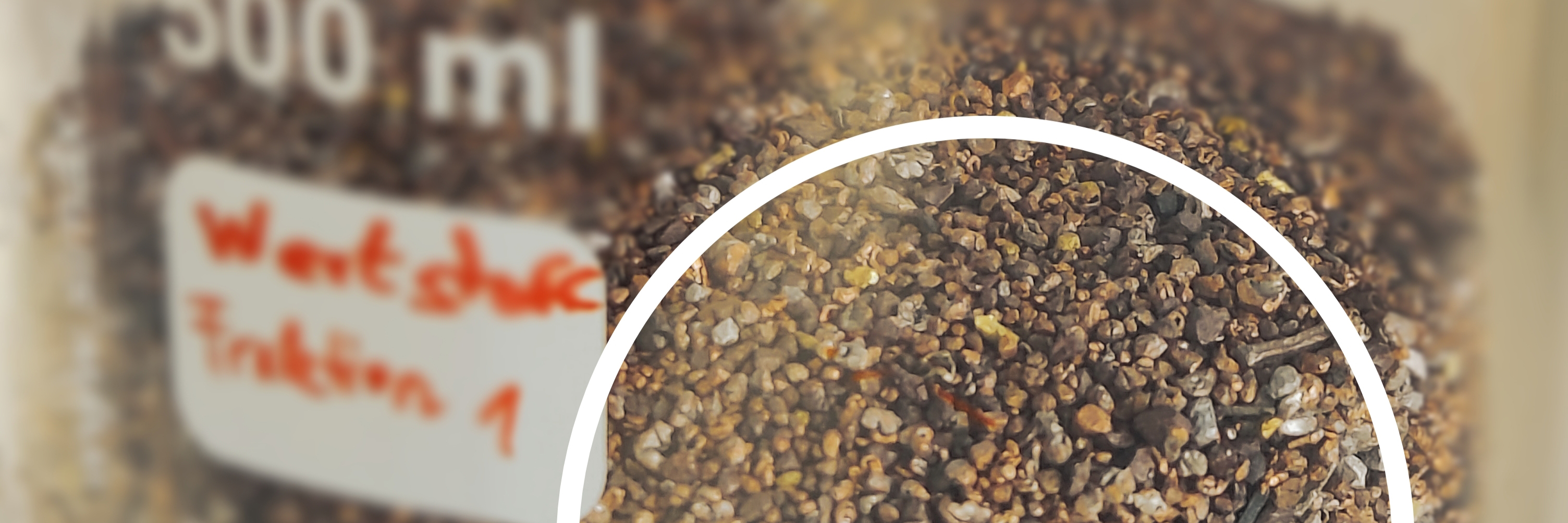Biohydrometallurgy
In biohydrometallurgy, microorganisms are used to form acids, bases and complexing agents for the aqueous extraction of metals from solids. Furthermore, microorganisms can be used to remove metals from the liquid phase by precipitation reactions. We use these natural processes for the leaching of raw materials from waste, the treatment of metal-containing wastewater and the biological remediation of contaminated sites. The goal here is always to close material cycles as resource-efficiently as possible.
The basis for all processes is the understanding of so-called "metal speciation". Metal speciation refers to the specific form in which a chemical element exists. The chemical properties (e.g. solubility) as well as the biological effect (e.g. toxicity) of different metal species can be very different. Microbes naturally change the speciation, a fact that we exploit in our processes. Direct measurements by mass spectrometry (e.g. LC-MSn; GC-MS, LC-ICP-MS) and spectroscopy (e.g. XAFS) as well as thermodynamic modelling form the basis for understanding speciation.
Microorganisms actively change the surrounding medium by forming acids and complexing agents. We use this circumstance to recover so-called critical raw materials from industrial residues (e.g. gallium from red mud from aluminium production) by means of "bioleaching". By the same means, metals can also be washed out of contaminated sites and subsequently recovered. We also use microbes to remove elements from wastewater by precipitation and return them to the cycle. The formation of insoluble metal species due to microbial metabolism is called "biological precipitation".
- Lenz, M., van Hullebusch, E.D., Farges, F., Nikitenko, S., Corvini, P.F.X., Lens, P.N.L. (2011). Combined speciation analysis by XANES, IC and SPME-GC-MS to evaluate biotreatment of concentrated selenium wastewaters. Environmental Science and Technology, 45 (3), 1067–1073.
- Hennebel, T, Boon, N, Maes, S., Lenz, M. (2015). Biotechnologies for Critical Raw Material Recovery from Primary and Secondary Sources: R&D Priorities and Future Perspectives. New Biotechnology, 32 (1), 121-127.
- Ujaczki, E., Feigl, V., Molnár, M., Cusack, P., Curtin, T., Courtney, R., O’Donoghue, L., Panagiotis, D., Hugi, C., Evangelou, M.W.H, Balomenos, E., Lenz, M. (2018). Re-using bauxite residues: benefits beyond (critical raw) material recovery. Journal of Chemical Technology & Biotechnology. 93 (9), 2498-2510.
- Potysz, A., Pędziwiatr, A., Hedwig, S., Lenz, M. (2020). Bioleaching and toxicity of metallurgical wastes. Journal of Environmental Chemical Engineering, 8, 104450.
- Lenz, M., van Hullebusch, E.D., Farges, F., Nikitenko, S., Corvini, P.F.X., Lens, P.N.L. (2011). Combined speciation analysis by XANES, IC and SPME-GC-MS to evaluate biotreatment of concentrated selenium wastewaters. Environmental Science and Technology, 45 (3), 1067–1073.
- Hennebel, T, Boon, N, Maes, S., Lenz, M. (2015). Biotechnologies for Critical Raw Material Recovery from Primary and Secondary Sources: R&D Priorities and Future Perspectives. New Biotechnology, 32 (1), 121-127.
- Ujaczki, E., Feigl, V., Molnár, M., Cusack, P., Curtin, T., Courtney, R., O’Donoghue, L., Panagiotis, D., Hugi, C., Evangelou, M.W.H, Balomenos, E., Lenz, M. (2018). Re-using bauxite residues: benefits beyond (critical raw) material recovery. Journal of Chemical Technology & Biotechnology. 93 (9), 2498-2510.
- Potysz, A., Pędziwiatr, A., Hedwig, S., Lenz, M. (2020). Bioleaching and toxicity of metallurgical wastes. Journal of Environmental Chemical Engineering, 8, 104450.


